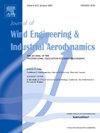Square-section prism with rounded edges in a uniform cross-flow: Effect of incidence angle and Reynolds number on the (un)steady aerodynamics and proneness to galloping
IF 4.2
2区 工程技术
Q1 ENGINEERING, CIVIL
Journal of Wind Engineering and Industrial Aerodynamics
Pub Date : 2025-02-01
DOI:10.1016/j.jweia.2024.105993
引用次数: 0
Abstract
The steady and unsteady aerodynamics of a slightly rough square-section prism with rounded edges of = 0.16 is studied experimentally for a wide range of Reynolds numbers and incidence angles. Surface pressures, time-averaged and fluctuating lift, drag, and pitch moment coefficients, as well as eddy shedding frequencies are measured simultaneously for Reynolds numbers between 100,000 and 8 million. Analysis of the data reveals drastic changes in the cross-sectional surface pressure distribution with increasing Reynolds number for all incidence angles between −45° and 3.25°, caused by the promotion of the separated-shear-layer reattachment on the side faces owing to the rounded edges. At = 0°, an unbounded supercritical flow regime exists, while at larger absolute incidence angles the upper transition and transcritical flow regimes appear and gradually spread over an increasing range of Reynolds numbers. The transitions from the critical to the supercritical flow regime and further to the upper transition are accompanied by sign reversals of the lift and pitch moment. Thereupon, the classical quasi-steady galloping models are applied to determine the stability boundaries of transverse and torsional galloping depending on the incidence angle and Reynolds number. Moreover, at specific combinations of both governing parameters the eddy shedding is fully suppressed.

求助全文
约1分钟内获得全文
求助全文
来源期刊
CiteScore
8.90
自引率
22.90%
发文量
306
审稿时长
4.4 months
期刊介绍:
The objective of the journal is to provide a means for the publication and interchange of information, on an international basis, on all those aspects of wind engineering that are included in the activities of the International Association for Wind Engineering http://www.iawe.org/. These are: social and economic impact of wind effects; wind characteristics and structure, local wind environments, wind loads and structural response, diffusion, pollutant dispersion and matter transport, wind effects on building heat loss and ventilation, wind effects on transport systems, aerodynamic aspects of wind energy generation, and codification of wind effects.
Papers on these subjects describing full-scale measurements, wind-tunnel simulation studies, computational or theoretical methods are published, as well as papers dealing with the development of techniques and apparatus for wind engineering experiments.

 求助内容:
求助内容: 应助结果提醒方式:
应助结果提醒方式:


